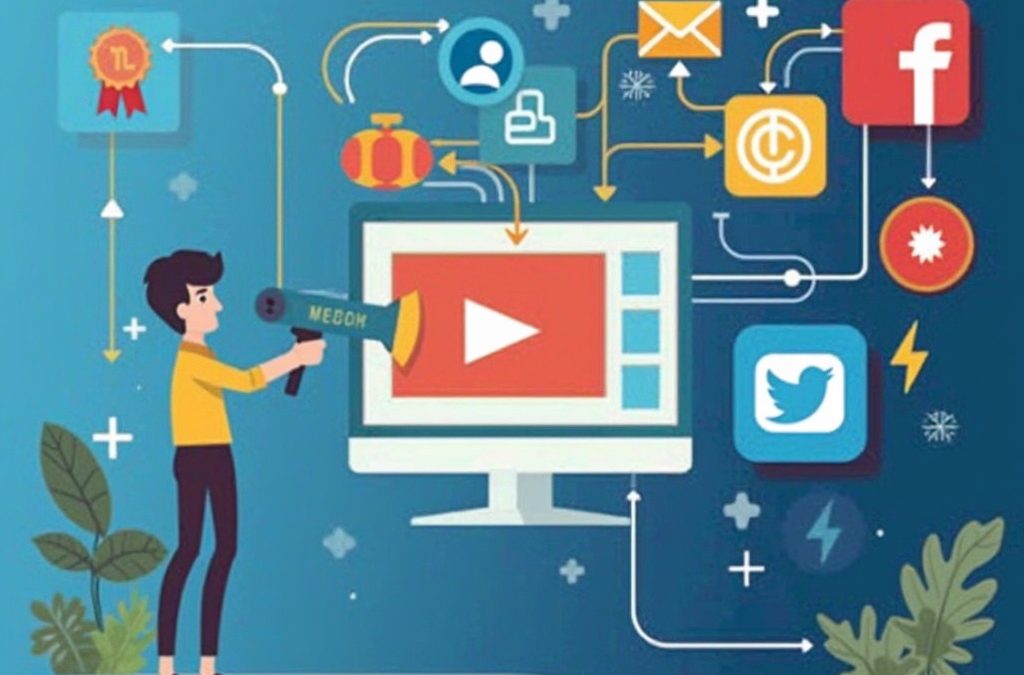Social media marketing automation has become essential for businesses looking to maximize their online presence and engagement. This comprehensive guide explores the most effective strategies and tools for automating your social media efforts, helping you save time while boosting your brand’s visibility and impact.
Key Takeaways:
- Automation tools can streamline content scheduling and posting
- AI-powered chatbots enhance customer service efficiency
- Data analytics automation provides actionable insights for strategy refinement
- Social listening tools automate brand mention tracking
- Automated reporting saves time and improves performance evaluation
Understanding Social Media Marketing Automation
Social media marketing automation refers to the use of software and tools to streamline and optimize various aspects of social media management. It’s not about replacing human creativity but rather enhancing it by reducing repetitive tasks and allowing marketers to focus on strategy and engagement.
The benefits of automation in social media marketing are numerous. It can help you maintain a consistent posting schedule, engage with your audience more effectively, and gather valuable data for informed decision-making. By leveraging automation, businesses can significantly improve their social media presence without a proportional increase in time and resources.

Key Automation Strategies for Social Media Marketing
To make the most of social media marketing automation, consider implementing these key strategies:
1. Content Scheduling and Posting: Use tools like Hootsuite, Buffer, or Sprout Social to plan and schedule your content in advance. This ensures a consistent posting schedule across all platforms, even during off-hours.
2. Chatbots for Customer Service: Implement AI-powered chatbots on platforms like Facebook Messenger to handle common customer inquiries quickly and efficiently, freeing up your team to focus on more complex issues.
3. Automated Social Listening: Utilize tools like Mention or Brandwatch to automatically track brand mentions, industry trends, and competitor activity across social platforms.
4. Data Analytics and Reporting: Leverage automation to collect and analyze social media performance data, generating regular reports that inform your strategy and demonstrate ROI.
5. Automated Ad Management: Use platforms like AdEspresso or Revealbot to automate your social media advertising campaigns, from ad creation to budget optimization.
Choosing the Right Automation Tools
Selecting the appropriate automation tools is crucial for the success of your social media marketing efforts. Consider these factors when choosing your toolkit:
- Integration capabilities with your existing platforms and workflows
- Ease of use and user-friendly interface
- Scalability to grow with your business needs
- Comprehensive analytics and reporting features
- Cost-effectiveness and ROI potential
Popular automation tools include Hootsuite, Buffer, Sprout Social, and Later. Each offers unique features, so it’s important to assess your specific needs and budget before making a decision.
Best Practices for Social Media Marketing Automation
To ensure your automation efforts are effective and maintain a human touch, follow these best practices:
1. Don’t Over-Automate: While automation can save time, it shouldn’t replace genuine human interaction. Strike a balance between automated and personal engagement.
2. Personalize Your Automated Responses: Use data and AI to create personalized automated messages that feel authentic and relevant to your audience.
3. Regularly Review and Update: Continuously monitor your automated processes and content to ensure they remain relevant and effective.
4. Integrate Automation Across Channels: Ensure your automation strategy works cohesively across all your social media platforms for a consistent brand experience.
5. Comply with Platform Rules: Stay updated on each social media platform’s guidelines regarding automation to avoid penalties or account suspension.
Measuring the Success of Your Automation Efforts
To gauge the effectiveness of your social media marketing automation, focus on these key performance indicators (KPIs):
- Engagement rates (likes, comments, shares)
- Response time to customer inquiries
- Follower growth rate
- Conversion rates from social media traffic
- Time saved on social media management tasks
Regularly analyze these metrics to refine your automation strategy and ensure it’s delivering the desired results for your business.
Conclusion
Automating your social media marketing can significantly enhance your online presence and engagement while freeing up valuable time and resources. By implementing the strategies and best practices outlined in this guide, you can create a more efficient, effective, and data-driven social media marketing approach. Remember, the goal of automation is to augment human creativity and strategy, not replace it entirely. With the right balance, you’ll be well-positioned to thrive in the dynamic world of social media marketing.
Sources:
Frequently Asked Questions (FAQs) on Social Media Marketing Automation
What is Social Media Marketing Automation?
Social media marketing automation involves using software to perform repetitive tasks on social media platforms without manual intervention. This includes scheduling posts, analyzing performance, engaging with followers, and more. It helps businesses save time, maintain a consistent online presence, and optimize their social media strategies based on data-driven insights.
How Does Social Media Scheduling Automation Work?
Social media scheduling automation helps streamline the planning and scheduling of posts. Tools like Hootsuite, Buffer, and Sprout Social allow marketers to organize content calendars in advance and identify optimal posting times to increase reach and impact. These tools enable businesses to maintain a strategic and proactive approach to social media marketing.
What Are the Benefits of Using AI-Powered Chatbots for Customer Service?
AI-powered chatbots enhance customer service efficiency by handling common customer inquiries quickly and efficiently. This frees up your team to focus on more complex issues, ensuring timely and personalized responses to customer queries.
How Can Automated Data Analytics and Reporting Help My Social Media Strategy?
Automated data analytics and reporting tools collect and analyze social media performance data, generating regular reports that inform your strategy and demonstrate ROI. These tools help you refine your social media approach by providing actionable insights, allowing you to adjust your strategies based on real-time data.
What Should I Consider When Choosing the Right Automation Tools for My Business?
When choosing automation tools, consider factors such as integration capabilities with your existing platforms and workflows, ease of use and user-friendly interface, scalability to grow with your business needs, comprehensive analytics and reporting features, and cost-effectiveness and ROI potential. Popular tools include Hootsuite, Buffer, Sprout Social, and Later.
How Can I Ensure My Automated Responses Feel Personal and Authentic?
To ensure your automated responses feel personal and authentic, use data and AI to create personalized messages that are relevant to your audience. Regularly review and update your automated processes and content to maintain their effectiveness and authenticity.
What Key Performance Indicators (KPIs) Should I Use to Measure the Success of My Automation Efforts?
To gauge the effectiveness of your social media marketing automation, focus on KPIs such as engagement rates (likes, comments, shares), response time to customer inquiries, follower growth rate, conversion rates from social media traffic, and time saved on social media management tasks. Regularly analyze these metrics to refine your automation strategy.
Can Social Media Marketing Automation Replace Human Interaction Entirely?
No, social media marketing automation should not replace human interaction entirely. While automation can save time and streamline tasks, it’s important to strike a balance between automated and personal engagement to maintain a human touch and build meaningful relationships with your audience.
People Also Ask
What are the key benefits of automating social media marketing?
Automating social media marketing offers several key benefits that can significantly enhance your online presence and engagement. Here are some of the most significant advantages:
- Time-Saving: Automation tools allow you to schedule posts, monitor engagement, and track brand mentions in advance, saving you a considerable amount of time. This enables your team to focus on more strategic and creative tasks[2][4][5].
- Improved Efficiency: By streamlining workflows, automation tools help in managing multiple social media platforms efficiently. For example, tools like Sprout Social’s Smart Inbox consolidate all your messages into one place, making it easier to manage and respond to customer interactions promptly[2][4].
- Enhanced Engagement: Automation ensures timely responses to customer inquiries and comments, which is crucial for building a strong online community. Features like chatbots and mention monitoring help in proactive engagement and reputation management[2][4][5].
- Data-Driven Insights: Automated analytics provide valuable insights into your social media performance, helping you refine your strategies and make data-driven decisions. Tools like Sprout Social and Sendible offer comprehensive analytics and reporting features[1][4][5].
How can I automate content scheduling and posting on social media?
Automating content scheduling and posting is one of the most effective ways to maintain a consistent social media presence. Here’s how you can do it:
- Use Scheduling Tools: Utilize tools like Hootsuite, Buffer, or Sprout Social to plan and schedule your content in advance. These tools allow you to create content calendars and queue posts across multiple platforms, ensuring a consistent posting schedule even during off-hours[1][2][4].
- Optimize Posting Times: Tools like Sprinklr’s Smart Scheduling feature can intelligently pick the best time to publish based on your audience’s peak activity time on every channel. This helps in maximizing engagement and reach[1].
- Content Calendars: Create detailed content calendars that outline your posting schedule for weeks or months in advance. This ensures that your content is well-planned and consistently delivered[1][4].
What role do AI-powered chatbots play in social media marketing automation?
AI-powered chatbots are a crucial component of social media marketing automation, particularly in enhancing customer service efficiency. Here’s how they can help:
- 24/7 Customer Service: Chatbots can instantly respond to messages and queries, even outside of business hours, ensuring uninterrupted customer service. This improves response times and customer satisfaction[1][2][5].
- Automated Responses: Chatbots can handle common customer inquiries, freeing your team to focus on more complex issues. Tools like Sprout Social’s bot builder allow you to automate canned responses, making customer interactions more efficient[1][2][4].
- Personalized Interactions: By using data and AI, chatbots can create personalized automated messages that feel authentic and relevant to your audience, enhancing the overall customer experience[2][5].
How can I track brand mentions and industry trends using social media automation?
Tracking brand mentions and industry trends is essential for maintaining a strong social media presence. Here’s how you can automate this process:
- Social Listening Tools: Utilize tools like Mention, Brandwatch, or Sprinklr to automatically track brand mentions, industry trends, and competitor activity across social platforms. These tools provide valuable insights into customer sentiment and industry trends[1][2][4].
- Automated Alerts: Set up automatic alerts or notifications for brand mentions or relevant keywords. This keeps you informed about important conversations without the need for constant manual monitoring[1].
- Sentiment Analysis: Tools like Coca-Cola’s “Share a Coke” campaign example show how automated tools can analyze sentiment and engagement, providing real-time feedback and measuring the campaign’s impact on brand sentiment and sales[1].
What are the best practices for implementing social media marketing automation?
To ensure your social media marketing automation efforts are effective and maintain a human touch, follow these best practices:
- Don’t Over-Automate: Strike a balance between automated and personal engagement. While automation saves time, it shouldn’t replace genuine human interaction entirely[5].
- Personalize Automated Responses: Use data and AI to create personalized automated messages that feel authentic and relevant to your audience[5].
- Regularly Review and Update: Continuously monitor your automated processes and content to ensure they remain relevant and effective. This includes updating your content calendars and chatbot responses as needed[5].
- Integrate Automation Across Channels: Ensure your automation strategy works cohesively across all your social media platforms for a consistent brand experience[5].
- Comply with Platform Rules: Stay updated on each social media platform’s guidelines regarding automation to avoid penalties or account suspension[5].

